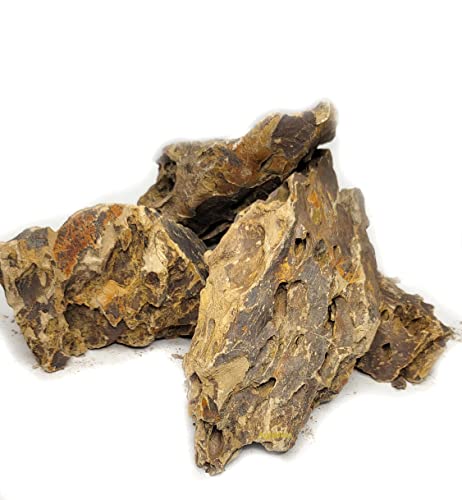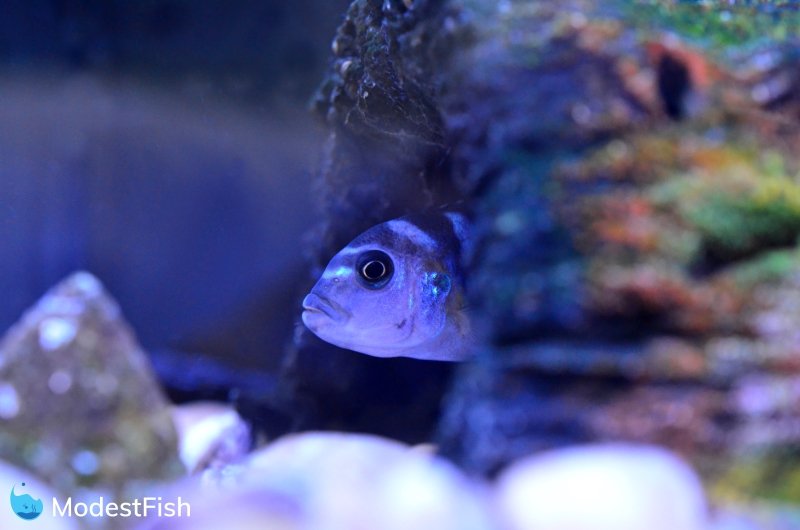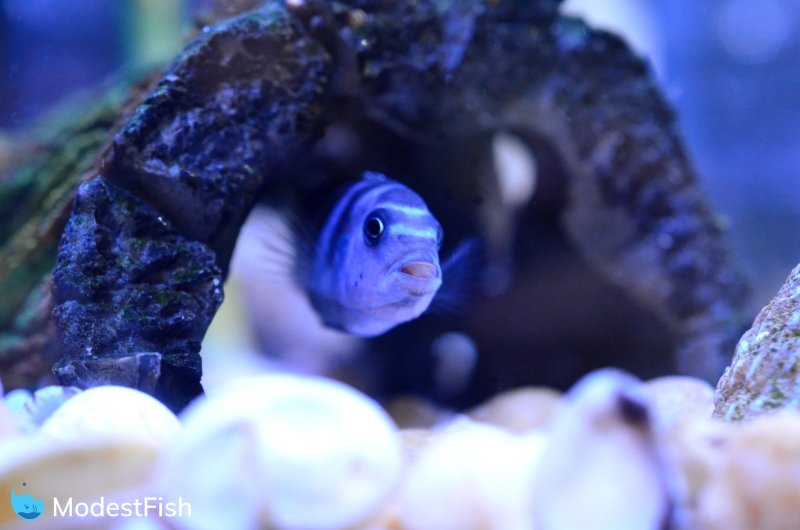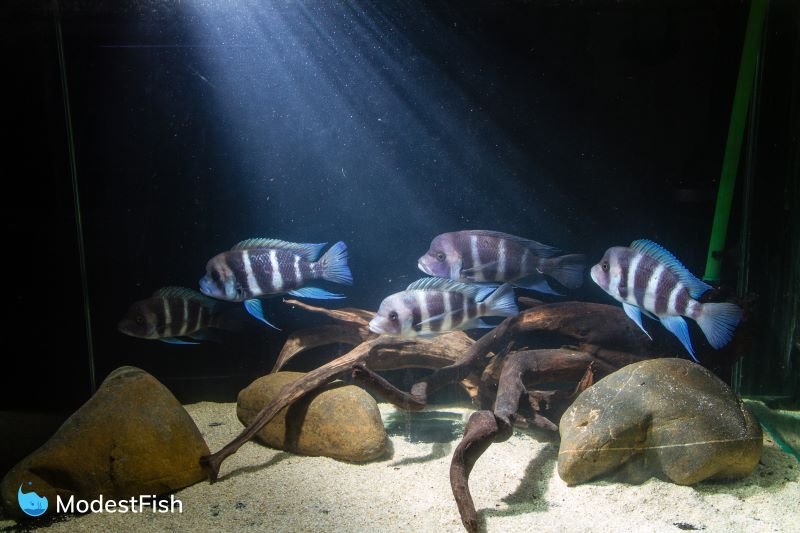Aquarium rocks are ideal for Cichlid tanks. Most types will use rocks to mark out their territory, as shelter and as a handy place to lay their eggs.
It’s vital to get your rocks from a safe source. Sure, free rocks can be tempting, but understand that you risk losing fish.
In this guide, I’ll show you how to choose safe rocks for your cichlids and review what I believe are the best for your aquarium.
Product Overview for Cichlid Rocks
| Preview | Product | |
|---|---|---|

|
4LBS of Aquascaping Seiryu Stone Rock Aquarium Tropical Fish Plant Shrimp Driftwood by Seiryu Stone | Buy on Amazon |

|
Pisces 9 lb Maple Aquascaping Rock for Aquarium (AM-ROCK003) | Buy on Amazon |

|
Natural Slate Stone 3 to 5 inch Rocks for Miniature and Fairy Garden, Aquascaping Aquariums, Reptile... | Buy on Amazon |

|
Aqualexs Aquarium Ohko Dragon Stone Rock Mixed Sizes | Buy on Amazon |

|
Underwater Galleries Big Rock Box, 10 Large Ceramic Cichlid Stone Aquarium Caves, Assorted Styles | Buy on Amazon |

|
Deep Blue Professional ADB80401 Large Texas Holey Rock Synthetic Coral for Aquarium, 12-Inch | Buy on Amazon |

|
Penn-Plax Deco-Replicas Granite Aquarium Ornament & Hideaway 8 Piece Set – Realistic Stone... | Buy on Amazon |
Last update on 2024-04-22 / Commissions Earned / Images from Amazon Product Advertising API
Why Rocks are Important for Cichlids

Most cichlids are territorial, like really, really territorial.
So having rocks in the tank is handy for a number of reasons.
Cichlids use rocks as a way to mark out their territory. They don’t think in terms of, “My area is in the back left corner of the tank.” It’s more like, “My territory is between this rock and that plant.”
Having enough rocks and decor in the tank is helpful since the fish use them as borders that they don’t go beyond.
I’ve seen really territorial cichlids try to defend the entire tank if they don’t have a way to tell one area from another.
I had a particularly homicidal severum who decided an entire 55 gallon was his. Once more decor was put in the tank, he staked out one corner instead of claiming the every inch of the aquarium.
Many species of cichlids like to hide in caves formed by rocks, especially Mbuna African cichlids. They will pick out a cave and then defend it against any other fish that tries to move in.
Even species that aren’t considered full-time “cave dwellers” like to have a hidey hole that they can retreat to if they’re feeling stressed.
For example, I have a big Texas cichlid that really isn’t supposed to live in a cave, but he will jet into the rockwork I have in the tank any time he feels threatened.
And lots of cichlids that don’t want to hide inside a cave like to hang out behind large rocks. That way, they feel like they have some cover and aren’t exposed to predators. Jack Dempseys do this a lot.
Many species also use rocks when they’re breeding. Angelfish, discus, severums and a whole lot more like to lay their eggs either in a cave or on a flat rock.
Without some sort of rocks in the tank, they may feel too stressed to spawn or rear fry.
How to Choose Your Cichlid Rocks

The “rocks” you put in your tank don’t necessarily have to be real rocks.
I promise, the fish aren’t going to jump out of the tank to protest being given fake rocks. They’re just glad to have something that fits their needs.
No Sharp Edges!
Be careful about rocks, real or not, that have sharp edges. Fish are awesome pets, but they’re not always the brightest of creatures.
Fish sometimes rub up against rocks and decor with sharp edges and hurt themselves, sometimes pretty badly. Especially if there’s something jagged at the mouth of their cave or in a tight corner they swim around a lot.
I’ve seen them scrape huge pieces of skin, scales and all, off their sides because the entrance of their cave has a sharp edge.
And they’ll just keep doing it because, like I said, they’re just not that smart.
Sometimes, you may need to smooth out the sharp edges with a rasp or metal hand file. You can file down natural or synthetic rocks, just go slowly so you don’t break anything off.
Pro Tip: To test rocks for sharp edges, place pantyhose over your hand and run them over the rock’s edges. If the panyhose gets snagged or torn, that edge could hurt your fish.
Not One Size Fits All
Not all rocks are going to be right for all species.
Huge rock caves might be too big for smaller fish to feel secure. A German blue ram or a rainbow kribensis won’t feel like they really have a hiding place in a cave big enough for an adult severum.
They need something that’s suited to their size.
On the flipside, lightweight artificial rocks can’t hold up to a bigger fish. You can’t make a cave big enough for them to get into.
And, if they get startled or upset, big fish can easily knock over lighter rocks. So you’ve got to make a judgement call about what size and material is going to work for your fish longterm.
7 Best Rocks for Cichlids Reviewed And Which Type of Cichlid They’re Suitable for

Now you know more about how to choose the best rock for your cichlid.
Here are what I consider the best rocks you can buy today.
1. Seiryu Aquarium Rock (Best for African Cichlids)

This beautiful blue-gray stone is really popular with aquascapers.
It does have somewhat sharp edges. These can be filed down with a rasp to smooth them out.
These rocks do contain some calcium carbonate so they can raise your GH/KH/pH. So they’re not the best choice for Central or South American cichlids, but they’re great for Africans.
They’re not the best by themselves if you’re trying to build caves, but they really do have great textures and shapes that make the tank more interesting.
- Material: limestone origin
- Effect on water chemistry: will raise GH/KH/pH
- Type of cichlid: African cichlids
- Curing: just needs rinsing

Last update on 2024-04-22 / Commissions Earned / Images from Amazon Product Advertising API
2. Pisces USA Strata Aquarium Rock (Suitable for all Cichlids)

This gorgeous sandstone looks a lot like petrified wood. I really like the interesting textures it adds to the tank, lots of long ridges, and the quartz sparkles when the light catches it.
I’ve never noticed it having any effect on the water chemistry.
Depending on the piece, it can have some sharp or rough edges. I did need to gently file it down with a rasp in a few places. You can find some flatter pieces that are good for stacking and cave building.
- Material: sandstone with lots of quartz
- Effect on water chemistry: none
- Type of cichlid: any kind
- Curing: just needs rinsing

Last update on 2024-04-22 / Commissions Earned / Images from Amazon Product Advertising API
3. Natural Slate Stone (Suitable for all Cichlids)

I love slate. It’s my “go to” thing when I need a really flat surface for cave building. It stacks really nicely and the dark gray/black color looks amazing in the tank.
If you have smaller fish, you can pile slate to make smaller caves. For bigger fish, you can stack bigger rocks to build up the sides and then use the slate for the roof.
Slate is completely inert and will not change your water chemistry.
Sometimes, the edges can be a little rough, but I’ve never really had a problem with them being sharp.
- Material: slate
- Effect on water chemistry: totally inert
- Type of cichlid: any kind
- Curing: just rinse it off

Last update on 2024-04-22 / Commissions Earned / Images from Amazon Product Advertising API
4. Aqualexs Aquarium Ohko Dragon Stone (Best for Small Cichlids)

These cute caves look like natural stone at first but are actually made of ceramic. I like that you can spread them out all over the tank, or make a messy pile that looks a lot like natural lake cichlid habitat.
These come in a variety of sizes that are good for dwarf cichlids and smaller African cichlids, like Mbuna. I used a few of these for German blue rams and they loved them.
Unfortunately, they don’t make a size big enough for heavyweights like Jack Dempseys or flowerhorns to get inside.
But you could stack smaller sizes together to form a wall that bigger species could get behind.
Since these are hollow, they don’t displace as much water as natural stone and aren’t nearly so heavy.
- Material: ceramic
- Effect on water chemistry: none
- Type of cichlid: African Mbuna, dwarf cichlids, maybe slightly larger species
- Curing: just rinse them

Last update on 2024-04-22 / Commissions Earned / Images from Amazon Product Advertising API
5. Underwater Galleries Cichlid Stones (Best for Medium to Large Cichlids)

These cute caves look like natural stone at first but are actually made of ceramic. I like that you can spread them out all over the tank, or make a messy pile that looks a lot like natural lake cichlid habitat.
These come in a variety of sizes that are good for dwarf cichlids and smaller African cichlids, like Mbuna. I used a few of these for German blue rams and they loved them.
Unfortunately, they don’t make a size big enough for heavyweights like Jack Dempseys or flowerhorns to get inside.
But you could stack smaller sizes together to form a wall that bigger species could get behind.
Since these are hollow, they don’t displace as much water as natural stone and aren’t nearly so heavy.
- Material: ceramic
- Effect on water chemistry: none
- Type of cichlid: African Mbuna, dwarf cichlids, maybe slightly larger species
- Curing: just rinse them

Last update on 2024-04-22 / Commissions Earned / Images from Amazon Product Advertising API
6. Deep Blue Professional Synthetic Texas Holey Rock (Best for Dwarf Cichlids and Mbuna)

Deep Blue Professional actually makes several different sizes and molds of synthetic holey rock.
This is pretty awesome since real holey rock is super expensive and puts off tons of calcium and carbonate.
You can lean them against each other or let them stand on their own.
Smaller cichlids, like dwarf species or Mbuna, can get inside the larger pieces. Several smaller cichlids could set up territories in the same rock.
It’s not really the best stuff to try and build a cave out of, but if you lean some of the biggest pieces together, you can make a centerpiece big enough for large cichlids to hide behind.
One thing about these, though, since they’re bright white, it does show every speck of algae that grows on it.
- Material: resin
- Effect on water chemistry: none
- Type of cichlid: dwarf cichlids and Mbuna, maybe larger species if you lean them together
- Curing: just rinse it

Last update on 2024-04-22 / Commissions Earned / Images from Amazon Product Advertising API
7. Penn Plax Stone Replica (Best for Dwarf Cichlid or Mbuna)

These little resin caves are really cute, but they do have some drawbacks.
They’re not meant for big fish, at all. Even if you piled them high enough for big fish to hide behind, they’re way too lightweight to hold up to big fish moving around.
They’re made of resin so they can’t hold up to something like a redhead cichlid or a frontosa if they get excited.
So they’re good for dwarf cichlids and juvenile Mbuna, but they’re not suited for anything bigger.
They also have really rough edges on some of the entrances. I’d recommend using a small rat tail rasp to smooth out the edges.
They do look really nice in the tank, though, and you can pile them around in different combinations.
- Material: resin
- Effect on water chemistry: none
- Type of cichlid: dwarf or Mbuna
- Curing: rinse and file down edges

Last update on 2024-04-22 / Commissions Earned / Images from Amazon Product Advertising API
Which is the Best Rock for Cichlids?
If you’re going to keep cichlids, having some rocks in the tank is a good idea. Many species use rocks to mark out their territory, as shelter and as a handy place to lay their eggs.
It’s important to get your rocks from a safe source. Sure, free rocks can be tempting, but understand that you risk losing fish.
If you’re going to use rocks you find lying around, don’t collect rocks from areas that may have been exposed to chemicals like fertilizers or pesticides and make sure you clean them really well.
It’s not hard to sanitize rocks to get rid of bacteria or any other harmful hitchhiker. It takes some extra time but it’s worth it to make sure pathogens don’t hitch a ride into the tank.
If the selection of rocks is scarce in your area, there are some awesome options for buying rocks online. Your fish won’t mind if they’re natural or synthetic.
You can create a beautiful centerpiece in your tank and then watch your cichlids move in and use it every day.
Cichlid Rocks Recap
| Preview | Product | |
|---|---|---|

|
4LBS of Aquascaping Seiryu Stone Rock Aquarium Tropical Fish Plant Shrimp Driftwood by Seiryu Stone | Buy on Amazon |

|
Pisces 9 lb Maple Aquascaping Rock for Aquarium (AM-ROCK003) | Buy on Amazon |

|
Natural Slate Stone 3 to 5 inch Rocks for Miniature and Fairy Garden, Aquascaping Aquariums, Reptile... | Buy on Amazon |

|
Aqualexs Aquarium Ohko Dragon Stone Rock Mixed Sizes | Buy on Amazon |

|
Underwater Galleries Big Rock Box, 10 Large Ceramic Cichlid Stone Aquarium Caves, Assorted Styles | Buy on Amazon |

|
Deep Blue Professional ADB80401 Large Texas Holey Rock Synthetic Coral for Aquarium, 12-Inch | Buy on Amazon |

|
Penn-Plax Deco-Replicas Granite Aquarium Ornament & Hideaway 8 Piece Set – Realistic Stone... | Buy on Amazon |
Last update on 2024-04-22 / Commissions Earned / Images from Amazon Product Advertising API
Don’t Just Go Looking for Rocks Outside
So, you might be tempted to grab rocks out of your yard and put them in your fish tank.
I mean, who wouldn’t. They’re already there, and they’re free, right?
Unfortunately, it’s not that simple.
You can use rocks that you find in the yard, or out in nature, but it is always a risk.
The biggest problem is that the rocks may have absorbed some sort of harmful chemicals. These could leach out of the rock, poisoning your fish.
Rocks in your yard could have been exposed to pesticides, chemical fertilizers or other toxins.
If you pick up rocks from local waterways, they could be exposed to industrial or agricultural pollutants.
Pro Tip: A lot of chemicals aren’t visible and don’t have any kind of scent. So the rock can look and smell clean, but still leach toxins.
Don’t collect rocks from areas with heavy industrial or agricultural runoff.
How to Sanitize Rocks Found Outside for Your Cichlid Tank
Another major concern about found rocks is that they may be covered in bacteria that could harm fish.
Never ever put found rocks in your aquarium unless you have thoroughly sanitized them. A friend of mine did that and ended up losing a substantial number of fish in his tank.
Give rocks a good scrub before you put them in your aquarium:
Equipment:
- Scrub brush
- Bucket
- Tap water
- Bleach (plain bleach with no added scents or cleansers, just the cheap generic stuff)
- Dechlorinator
Steps:
1. Scrub off any visible dirt with a scrub brush and water, don’t use soap!
2. Mix 1 part water with 20 parts bleach.
3. Cover the rock(s) with the bleach solution and let them soak for half an hour.
4. Dump out the bleach mix and rinse the rocks until you no longer smell chlorine.
5. Cover the rocks with water and add a 5 times the normal dose of dechlorinator for that volume of water.
6. Let the rocks soak another half hour.
7. Dump the water and let the rocks air dry.
Pro Tip: Sanitizing rocks will remove bacteria and other pathogens, but it won’t remove chemicals like pesticides that they have absorbed.
Testing Potential Rocks for Your Cichlids
It’s also a good idea to test rocks before you put them in your tank.
Some rocks contain calcium carbonate (CaCO3).
Over time, this can leach both calcium and carbonate into your water. The calcium raises the general hardness (GH) and the carbonate raises the carbonate hardness (KH). An increase in KH will also increase your pH.
It’s something to be aware of if you’re trying to keep your water within certain parameters.
Carbonate rocks aren’t a great idea for soft water loving fish, like Central and South American cichlids. They don’t appreciate the extra GH and higher pH.
But, if you have soft water and are trying to up the GH, for something like African cichlids, rocks that contain calcium carbonate may actually be helpful to you.
It’s easy to test rocks to see if they contain calcium carbonate. All you need is an aquarium nitrate test kit. They’re not that expensive and it’s a good idea to have one of these anyway so you can monitor your water parameters.
Nitrate tests have two test solutions in them. Test solution #1 contains sulfuric acid, which will interact and fizz if there’s any calcium carbonate in the rock, just like when you mix baking soda and vinegar.
Just make sure not to get it on your skin!
Steps:
1. Put a few drops of nitrate test solution #1 on the rock.
2. Look for any fizzing or bubbling.
3. Rinse off testing area with a little water.
